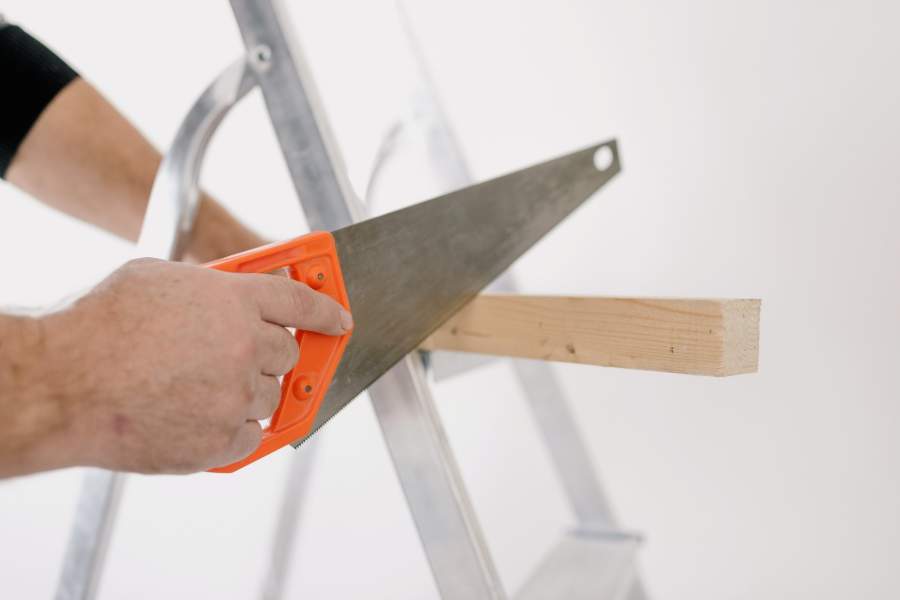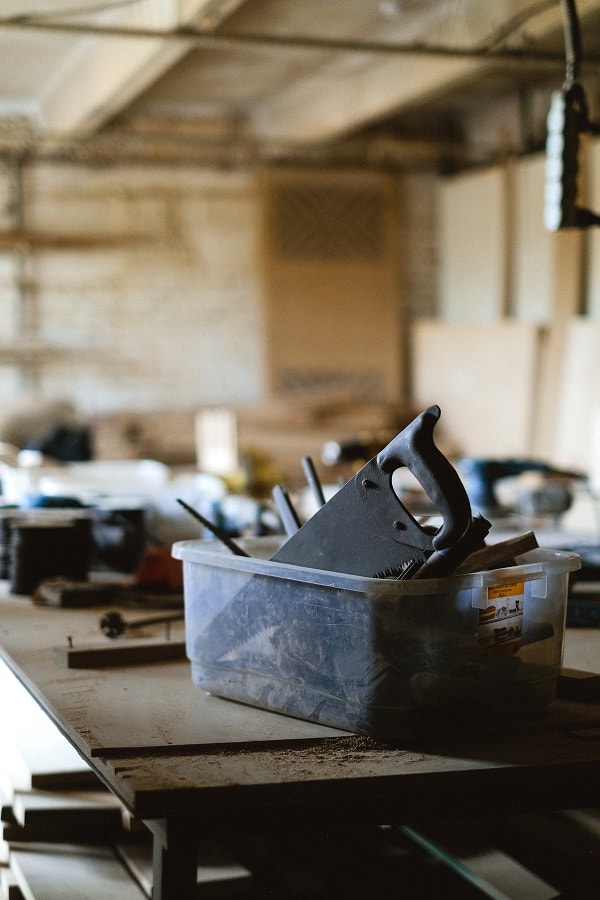As an Amazon Associate we earn from qualifying purchases.
A hand saw is the most efficacious and resilient workshop tool. However, it can get rusty, caked, and clogged with glue, pitch, and other materials. Here is an article that breaks down step by step guide on how to clean a hand saw blade.
Contents
-
How to Clean Hand Saw Blade
- Materials Required
- Step 1: Use Screwdrivers
- Step 2: Scrape The Grime
- Step 3: Use Vinegar
- Step 4: Use Baking Soda
- Step 5: Alternative Method of Using Evaporust.
- Step 6: Sanding the Wood
- Step 7: Use Linseed Oil to the Wood Handle
- Step 8: Using Wax
- Step 9: Cleaning the Teeth of the Blade
- Step 10: Assembling It All
- Maintenance of Hand Saw
- Frequently Asked Questions
- Conclusion
How to Clean Hand Saw Blade
The clogged blade can look dull, and the glue in the saw can make the blade blunt. To clean a rusty saw, you need patience and the right tools. Then, it just needs deep cleaning to bring back the shine, luster, and sharpness.
Materials Required
- Driller
- Screwdriver
- Saw holder
- Sandpaper
- Right angle screwdriver
- Wax
- Vinegar/baking soda/ Evaporust
- Wired Brush
- Linseed oil
- Soft cloth/rag/paper towel

Step 1: Use Screwdrivers
The very step to clean the saw is to remove it from the handle. This makes it easier to clean and restore.
- Use a fitting screwdriver to remove the wooden handle.
- If the screwdriver isn’t working, then you can use a driller. With the help of the driller, you can make some space in the handle.
- This may take time and effort, especially if the blade is rusted. If the screws are not coming off, then spray penetrating oil.
- Next, leave it for a minute and then use a screwdriver to unscrew the screws from the handle.
Using a right-angle screwdriver will accelerate the procedure. Pull the handle carefully, and then you can proceed with the restoration procedure.
Here is a video guide to follow.
Step 2: Scrape The Grime
After you remove the scares, put it safely. You need to scrape off thee the rust from the workshop tool.
- Use sandpaper to remove the rusted iron grime from the hand saw.
- Once you remove the dirt using a single-edged razor to scrape the wax and grime.
- Do it carefully without making scratches on the tool.
- Do it once or twice to scrape off the dirt properly.
Sandpaper is a more convenient tool as it does not put your hand at risk.
Step 3: Use Vinegar
Scraping cannot remove the rust properly from the blade. To scour the rust from the metal hand saw, you have to use acid.
- Pour vinegar in a plastic tray and put equal parts of water.
- Soak the hand saw in it for 20 minutes.
- Next, use metal wool or metal brush to scrub the layers of rust from the tool.
- Keep scrubbing with scrubber and sandpaper alternatively.
- After the metal is cleaned, wash it off with water.
Citric acid can be used alternatively if you don’t have vinegar. However, vinegar works more effectively than citric acid.
Step 4: Use Baking Soda
Acid can harm the metal and leave spots that do not look glamorous. You can use baking soda as an alternative to acid. Baking soda can also be used for cleaning dreads.
- Put the hand saw blade in warm water for a couple of minutes.
- After that, sprinkle baking soda directly on the blade.
- Spread the baking soda properly on the rusted areas.
- Next, leave it for an hour, and after that, start scouring.
- Use a scouring pad or metal brush to scrape off all the rust from the metal.
Applying baking soda does not harm the metal and is a cost-efficient procedure. Moreover, it is easily available at home.
Step 5: Alternative Method of Using Evaporust.
It is an alternative method that has become popular recently. It cleans without elbow scrubbing.
- Pour Evaporust in water and soak the hand saw.
- Keep it soaked overnight.
- All the scum, dirt, and grime go into the solution. You will see a black layer on the saw.
- When it is black, remove the saw from the solution
- Don’t get scared with the black layer on the saw. It is just from the chemical reaction that can be removed with ease.
- Use a paper towel and remove the back tint from the saw.
Applying Evaporust is better than applying vinegar as it does not harm the metal. And using Evaporust saves from painful scrubbing.

Step 6: Sanding the Wood
After cleaning dirt, grime, and layers of dust from the saw, it is time to clean the handle. Restoration and cleaning procedure also includes cleaning of the wooden handle.
- Use an orbital sander machine for sanding the layer of the wood.
- The orbital sander helps remove the upper layer of the wood. It helps in finishing the wood.
- Use a screwdriver to redesign the carves.
- Next, polish the wood with wood polish. It gives shine and makes it look new. X
Step 7: Use Linseed Oil to the Wood Handle
If you feel sanding the wood is difficult as it requires too much effort, use linseed oil to clean.
- Boil some amount of linseed oil. Keep it aside, and when it is cold enough to touch, use it to restore the handle.
- Put some in the paper towel. Apply linseed oil liberally on the grime and coat all the surfaces with linseed oil.
- You can use an old cotton towel to apply linseed oil. At first, test it on a patch by applying a small amount of linseed oil.
- Leave it for an hour and let it dry.
- Use a cotton pad to remove the extra linseed oil from the handle.
Applying linseed oil helps in cleaning grime and dirt from the handle. It also gives shine to the handle.
Step 8: Using Wax
After cleaning the hand saw, it is essential to lock the shine to bring back its aesthetic look.
- Use a rag or soft cotton cloth to apply wax on the metal.
- Apply it evenly and cover all the surfaces of the hand saw.
- Let it dry for 10-15 minutes. When it is completely dry, buff off the extra coating with a cloth.
- Use a microfiber cloth and vigorously brush it to remove all the extra wax paste from the saw.
The wax helps in rust build-up on the saw. In addition, the heavy coating of wax ensures the smooth running of the hand saw.
Step 9: Cleaning the Teeth of the Blade
Cleaning the blade of the saw ensures it is sharp enough to have smooth cuts in the wood.
- At first, clamp the saw in between two wooden blocks. If you find it difficult to clamp, you can find clamper at an inexpensive cost.
- Clamp it well, so the teeth of the saw upward. Make sure it is tight and does not move when you start sharpening.
- Use the right sharpening file to sharpen the teeth of the saw. To select the right file, you can put the file in the teeth point and mark the point where the teeth end.
- If the mark is over halfway, then select another file. After selecting the correct file, start sharpening.
- Sharp each tooth individually and do it till the points become sharp.
- Cleaning and sharpening of the teeth ensure fine and smooth cuts from the saw.
Step 10: Assembling It All
After cleaning and restoration of the saw, the last step is to reassemble.
But, first, fix the handle properly with the saw.
Second, fix the screws which you have appropriately opened. Use a screwdriver to secure the screw.
When everything is fixed, no one will mistake your saw for an old one. It is completely restored in simple steps.
Here are some tips to follow for cleaning hand saw.

Maintenance of Hand Saw
After you complete cleaning, it is essential to maintain it well to prevent rusting and dirt build-up.
- Keep the hand saw dry. After every use, keep it in a box
- Lubricate the saw after every use. Use gun oil or paste wax to lubricate the saw. It can easily be wiped on with a rag. This is also a common practice for cleaning paint ball guns.
- Oil the handle. Use boiled linseed oil to prevent dirt or moisture from settling on the wood.
- Frequently use a razor to remove blade rust. Scrub the stubborn places with sandpaper.
- Once in a year, sharpen the blade with filling.
Frequently Asked Questions
How Do I Clean Hand Saw Blade After Use?
Take some acetone and put it in a paper towel. Wipe off the sap, glue and, other debris that gets collected on the hand saw. Wipe once or twice and, it will clean the saw for use.
Is Vinegar Good for Cleaning Saw?
Vinegar can clean the saw properly, but it can damage the metal. It is better to use baking soda or Evaporust. Another way to ensure there is no mark or spot left use two tablespoons of baking soda with vinegar and leave it for 2 hours. Wash it off in running water to clean rust and gunk from the hand saw.
Can I Use a Rusty Saw?
It is not advisable to use a rusty saw. It can decrease the efficacy of the saw. In addition, it is difficult to operate a rusty saw than a cleaner one.
Conclusion
There is nothing more irritating than cleaning a rusty tool. But with the help of the above simple steps, you won’t throw away any essential tool in the bin. Hand saw gives fine cut to the wood, so it is necessary to keep it clean.
